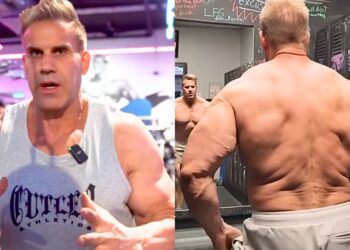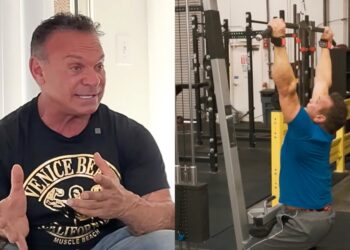Huge, flared lats are a symbol of a powerful physique. They also give you a V-taper, typifying the ideal upper body by improving aesthetics. However, many people struggle to engage the lats effectively when working their back, preventing optimal development.
The lower lats can be challenging to activate effectively due to a lack of mind-muscle connection, making it difficult to fully contract the muscle fibers during each repetition.
As a personal trainer with over three decades of experience, I’ve helped several athletes bring up their lower lats using specific exercises. This article lists five of the best lower lat moves for building a dense, wide back.
Recent Updates: On June 8, 2024, Fitness Volt’s Senior Editor, Vidur Saini (American Council on Exercise-CPT), updated the article and added actionable expert tips throughout the piece to improve the reader experience.
Level Up Your Fitness: Join our 💪 strong community in Fitness Volt Newsletter. Get daily inspiration, expert-backed workouts, nutrition tips, the latest in strength sports, and the support you need to reach your goals. Subscribe for free!
5 Best Lower Lat Exercises
The five exercises that follow will work your entire lat muscle. Follow the cues provided to place more emphasis on the lower lats.
- Lat Pull-In
- Dumbbell Row To Hips
- Seated Band Row
- Straight-Arm Lat Pulldown
- Underhanded Bent-Over Barbell Row
1. Lat Pull-In
| Sets & Reps | Equipment Needed | Target Muscles |
| Hypertrophy: 3-4 x 10-15, Strength: 4-5 x 5-8 | Cable machine, bench | Lats, biceps brachii, posterior deltoids, rhomboids, trapezius |
The lat pull-in is a unilateral variation of the lat pull-down that better engages the lower lats. Unilateral exercises are great for fixing muscle imbalances and developing a mind-muscle connection.
“As you initiate the pull, imagine driving your elbows down and back, as if trying to touch them to your back pockets,” cues Saini. But by doing this, you prioritize lat engagement over bicep activation, leading to stronger contractions.
Step-by-Step Guide:
- Place a bench in front of a cable pulley machine and adjust the pulley to its highest setting.
- Grab the handle in your right hand and sit on the bench so your right side is facing the pulley machine.
- Driving through your elbow, pull the handle to your chest level.
- To get a full lower lat contraction, touch your elbow to your hip bone.
- Contract the lower lat in this position.
- Slowly return to the start position, allowing the lats to fully extend.
- Repeat for reps before switching sides.
Pro Tip: Sit on the bench astride for better stability and keep your torso upright throughout the movement.
| Difficulty | Progression | Regression |
| Beginner | Dumbbell row to hips | Australian pull-up (feet on the ground) |
2. Dumbbell Row to Hips
| Sets & Reps | Equipment Needed | Target Muscles |
| Hypertrophy: 3-4 x 10-12 (per side), Strength: 4-5 x 6-8 (per side) | Dumbbells | Lats, rhomboids, trapezius, posterior deltoids, biceps brachii |
The dumbbell row to hips is a single-arm row variation. You can target the lower lats better by adjusting the line of pull. Rather than rowing the dumbbell up, you should pull back in an arc-like motion.
The dumbbell should start under your shoulder and finish at your hip, just like in the previous exercise. This allows for a full lower lat contraction.
Step-by-Step Guide:
- Stand alongside a bench with a dumbbell in your right hand.
- Place your left hand on the bench for support and step your left leg back in a staggered stance. In this position, your torso should be at a 45-degree angle.
- With the dumbbell hanging directly below your shoulder, row the weight up and back to touch your hip.
- Keep your shoulders down and your chest up as you row. Hold the contraction for a second.
- Slowly return to the starting position and repeat for the required reps before switching sides.
| Difficulty | Progression | Regression |
| Beginner | Double arm dumbbell row-to-hip | Seated row (machine or band) |
| Intermediate | Renegade row (add a push-up component) | Incline dumbbell row (decreased bodyweight leverage) |
| Advanced | Kroc row (high-volume, explosive style) | Dumbbell row with chest support (bench or incline) |
Pro Tip: Actively retract your shoulder blades and hold for a brief pause (1-2 seconds) at the movement’s top before lowering the dumbbell. It enhances the mind-muscle connection and targets the lower trapezius and rhomboids
3. Seated Band Row
| Sets & Reps | Equipment Needed | Target Muscles |
| Hypertrophy: 3-4 x 15-20, Strength: 4-5 x 8-12 | Resistance band | Lats, rhomboids, trapezius, posterior deltoids, biceps brachii |
The seated band row is a variation of the cable seated row that doesn’t restrict you to the predetermined path of the machine. You won’t be able to use as much resistance when using the band, but if you place this exercise third in your routine after the two just described, your lats will already be exhausted by the time you get to this movement.
Doing the seated row with a band keeps your lats under constant tension. To keep the emphasis on the lower lats, be sure to externally rotate your shoulders with your scapula slightly depressed and your chest up. While you’re doing the exercise, think about engaging the lower lats rather than the trapezius.
Level Up Your Fitness: Join our 💪 strong community in Fitness Volt Newsletter. Get daily inspiration, expert-backed workouts, nutrition tips, the latest in strength sports, and the support you need to reach your goals. Subscribe for free!
Step-by-Step Guide:
- Sit on the floor with your legs extended.
- Place a loop resistance band around your mid feet, holding the other end with both hands in a neutral grip.
- In this position, your hands should be at knee level. Maintain an upright torso and a neutral spine.
- Row your arms back, keeping the elbows tucked in at your sides until the hands are at hip level. Hold for a second as you contract the lower lats.
- Slowly return to the start position and continue for the required rep count.
Pro Tip: Initiate the row by squeezing your shoulder blades together before flexing your elbows. The pre-activation ensures they are the primary movers and maximize stimulation.
| Difficulty | Progression | Regression |
| Beginner | Use a heavier resistance band | Use a lighter resistance band |
| Intermediate | Staggered stance row (increase core engagement) | Single-arm band row |
| Advanced | Kneeling band row (add instability) | Face pull (emphasizes rear delts and upper back) |
4. Straight-Arm Lat Pulldown
| Sets & Reps | Equipment Needed | Target Muscles |
| Hypertrophy: 3-4 x 12-15, Strength: 4-5 x 6-8 | Cable machine with straight bar attachment | Lats, teres major |
The straight-arm lat pull-down stretches out your lats in the starting position and brings them to a fully contracted position at the bottom. The key to engaging the lower lats is to squeeze them as you hold the bottom position for a two to three-second count.
Step-by-Step Guide:
- Set the cable pulley to its highest setting and attach a handlebar to the cable.
- Grab the handle with both hands using an overhand grip.
- Take a couple of steps back so your arms are angled at about 45 degrees with the floor. Lean your upper body forward slightly and keep your arms straight throughout the movement.
- Keeping the shoulders down and the scapula slightly depressed, pull the bar down and into your hips. Hold the bottom position for two to three seconds as you contract the lower lats.
- Slowly return to the start position. Repeat for the required rep count.
Pro Tip: To maximize lower lat engagement, visualize pulling the bar down and back as if trying to tuck it into your hips instead of pulling it straight down.
| Difficulty | Progression | Regression |
| Beginner | Use a lighter weight | Banded variation |
| Intermediate | Slow eccentric pulldown (emphasize the lowering phase) | Kneeling pulldown (decreased leverage) |
| Advanced | Single-arm straight-arm pulldown | Dumbbell pullover (similar movement pattern) |
5. Underhanded Bent-Over Barbell Row
| Sets & Reps | Equipment Needed | Target Muscles |
| Hypertrophy: 3-4 x 8-12, Strength: 4-5 x 4-6 | Barbell, weight plates | Lats, rhomboids, trapezius, biceps brachii |
The underhanded bent-over barbell row is a variation of the standard barbell bent-over row, in which your hand position is reversed. It allows you to depress the scapula and keep your shoulders down, which helps better engage the lower lats.
This exercise also places more emphasis on the biceps than the standard barbell bent-over row.
Step-by-Step Guide:
- Place a loaded barbell on the floor in front of you. Stand with your feet hip-width apart.
- Hinge at your hips to reach down and grab the bar with a shoulder-wide underhand grip.
- Depress your shoulders and squeeze the shoulder blades together as you row the bar up to your ribs. Hold the top position for a second and contract the lower lats.
- Lower the bar until your arms are fully extended, and repeat for the required rep count.
Pro Tip: Maintain your torso at 45 degrees and extend the scapula completely in the bottom position for an optimal lower lat stretch and better hypertrophy.
| Difficulty | Progression | Regression |
| Beginner | Use a lighter barbell or dumbbells | Pendlay row (barbell starts from the floor each rep) |
| Intermediate | Yates row (barbell to chest) | Barbell T-bar row (supported chest) |
| Advanced | Landmine row (single-arm variation) | Dumbbell bent-over row |
Best Lower Lats Workout
Now that we’ve identified five effective lower lat exercises, let’s put them together into a workout. This 16-set workout will hit the entire latissimus dorsi. However, following the abovementioned cues will help focus on the lower lats.
| Exercise | Sets | Reps | Rest (minutes) |
| Underhanded Bent-Over Barbell Row | 3 | 8-12 | 1-2 |
| Lat Pull-In | 3 | 10-15 | 1 |
| Dumbbell Row to Hips (per side) | 3 | 10-12 | 1-2 |
| Seated Band Row | 3 | 15-20 | 1 |
| Straight-Arm Lat Pulldown | 3 | 12-15 | 1 |
What are Lower Lats?
The latissimus dorsi is a fan-shaped, broad, and flat muscle occupying most of the lower posterior thorax. It stretches to the sides, behind the arm, and is partly covered by the trapezius on the back near the midline.
When we talk about the lower lats, we are referring to the group of fibers that insert into the lower third and fourth ribs where it interdigitates with the external oblique muscle and inferior angle of the scapula and the iliac crest of the hip bone.
Notably, it is not possible to fully isolate the lower lats while training. That’s because all latissimus dorsi muscle fibers have the same insertion point on the upper arm. So, when you do a lat exercise, all lat fibers are working together. However, you can better activate the lower portion of the lats by modifying your exercise form and training technique.
Summary
While you cannot totally isolate the lower lats, you can focus on them with the right exercises done in the right way. The five exercises covered in this article will help you engage and contract the lower lats. Perform this workout twice per week for the best results.








